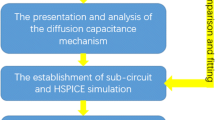Abstract
A 3D model of the negative-channel metal-oxide semiconductor (NMOS) structure in a 65-nm complementary metal-oxide semiconductor (CMOS) inverter was built based on technology computer-aided design (TCAD) three-dimensional (3D) device simulation software. The single-event effect caused by a heavy ion at different incident positions was simulated and analyzed using the TCAD–HSPICE mixed-mode simulation. Then, an analytical model was established to describe the relationship between the incident position of the ion and the charge collected by the NMOS drain. Finally, an HSPICE simulation approach based on this model was developed and verified by simulations.














Similar content being viewed by others
References
Artola, L., Gaillardin, M., Hubert, G., Raine, M., Paillet, P.: Modeling single event transients in advanced devices and ICs. IEEE Trans. Nucl. Sci. 62(4), 1528–1539 (2015)
Ferlet-Cavrois, V., Massengill, L.W., Gouker, P.: Single event transients in digital CMOS—a review. IEEE Trans. Nucl. Sci. 1760(3), 1767–1790 (2013)
Liu, Z., Chen, S.M., Liang, B., Liu, B.W., Zhao, Z.Y.: Research on bipolar effect in single-event transient. Acta Phys. Sin. 59(1), 649–654 (2009)
Kauppila, J.S., Sternberg, A.L., Alles, M.L., Francis, A.M., Holmes, J., Amusan, O.A., Massengill, L.W.: A bias-dependent single-event compact model implemented into BSIM4 and a 90 nm CMOS process design kit. IEEE Trans. Nucl. Sci. 56(6), 3152–3157 (2009)
Kauppila, J.S., Massengill, L.W., Ball, D.R., Alles, M.L., Schrimpf, R.D., Loveless, T.D., Maharrey, J.A., Quinn, R.C., Rowe, J.D.: Geometry-aware single-event enabled compact models for sub-50 nm partially depleted silicon-on-insulator technologies. IEEE Trans. Nucl. Sci. 62(4), 1589–1597 (2015)
Saremi, M., Privat, A., Barnaby, H.J., Clark, L.T.: Physically based predictive model for single event transients in CMOS gates. IEEE Trans. Electron Devices 63(6), 2248–2254 (2016)
Black, D.A., Robinson, W.H., Wilcox, I.Z., Limbrick, D.B., Black, J.D.: Modeling of single event transients with dual double-exponential current sources: implications for logic cell characterization. IEEE Trans. Nucl. Sci. 62(4), 1540–1549 (2015)
Golke, K.W.: Determination of funnel length from cross section versus LET measurements. IEEE Trans. Nucl. Sci. 40(6), 1910–1917 (1993)
Chen, Y., Tang, M.: Study on Single Event Effect Mechanism and Hardened Techniques of Field Effect Transistor. Xiangtan University, Hunan (2016)
VisualTCAD 1.7.2: VisualTCAD User’s Guide Cogenda Pte Ltd. Su Zhou, China (2017)
Qin, J., Chen, S., Guo, C., Du, Y.: Simulation study of the single-event effects sensitivity in nanoscale CMOS for body-biasing circuits. IEEE Trans. Device Mater. Reliab. 14(2), 639–644 (2014)
Privat, A., Clark, L.T.: Simple and accurate single event charge collection macro modeling for circuit simulation. In: IEEE International Symposium on Circuits & Systems, Lisbon, Portugal, pp. 1858–1861 (2015)
Liu, J., Wang, Y., Chen, G., Li, R., Li, Y., Fu, D.: Modeling of single event pulse with Verilog A: implementation and application. In: IEEE International Nanoelectronics Conference, Chengdu, China, pp. 1–2 (2016)
HSPICE User Guide: Basic Simulation and Analysis Synopsys. California, USA (2013)
Laux, S.E., Hess, K.: Revisiting the analytic theory of p-n junction impedance: improvements guided by computer simulation leading to a new equivalent circuit. IEEE Trans. Electron Devices 46(2), 396–412 (1999)
Yi, T., Liu, Y., Yang, Y.: A study of PN junction diffusion capacitance of MOSFET in presence of single event transient. J. Electron. Test. 33(6), 769–773 (2017)
He, Y.B., Chen, S.M.: Impact of circuit placement on single event transients in 65 nm bulk CMOS technology. IEEE Trans. Nucl. Sci. 59(6), 2772–2777 (2012)
Acknowledgements
This research was partially supported by Equipment Pre-research Project of China (No. 41424050607).
Author information
Authors and Affiliations
Corresponding author
Rights and permissions
About this article
Cite this article
Yi, T., Liu, Y., Wu, Z. et al. HSPICE model and circuit simulation for a single-event effect caused by ions at different incident positions. J Comput Electron 17, 994–1000 (2018). https://doi.org/10.1007/s10825-018-1201-1
Published:
Issue Date:
DOI: https://doi.org/10.1007/s10825-018-1201-1




